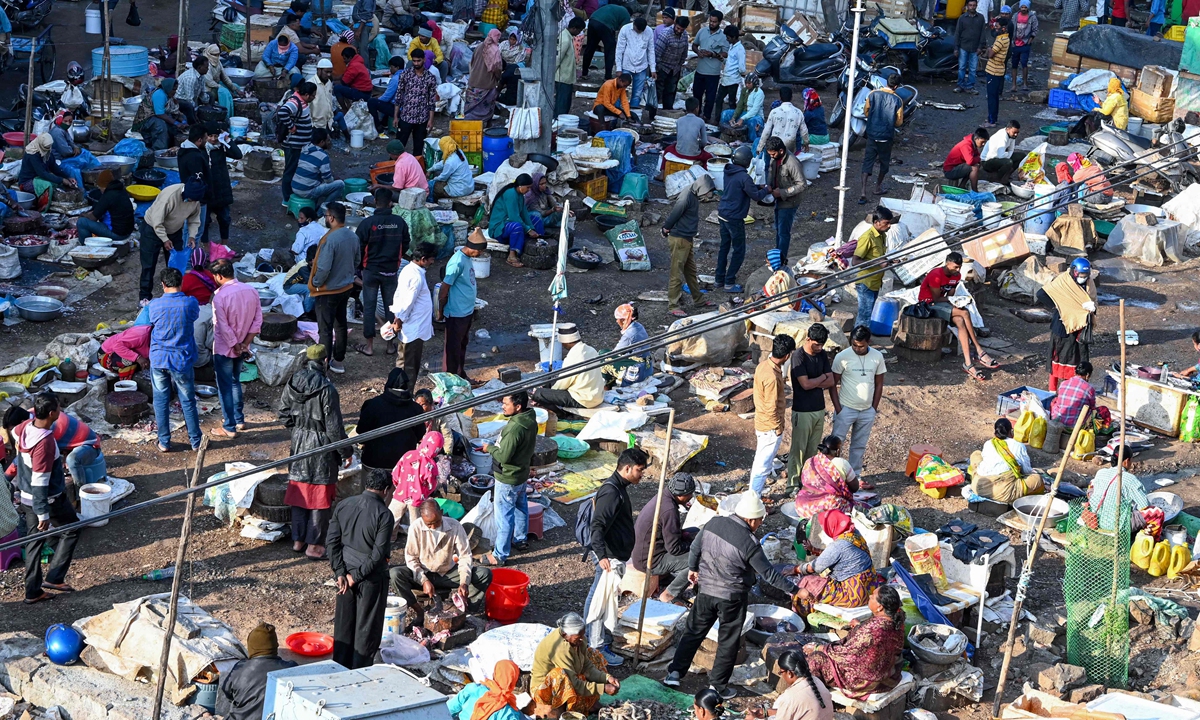India to surpass China in population at mid-year, but demographic benefits may be tough to achieve: observers

People buy fish at a wholesale fish market in Hyderabad, India on November 21, 2022, a day which is also marked as World Fisheries Day. World Fisheries Day is celebrated on November 21 every year to demonstrate solidarity with all fisher folk, fish farmers and concerned stakeholders throughout the world. Photo: VCG
India is projected to overtake China with 3 million more people in the middle of 2023, the latest UN data showed. Chinese observers believe the laurel of being the world's most populous country comes with promising prospects of a "demographic dividend" for India, but many questions lie ahead for India to truly reap the dividend.
India's population will hit 1.4286 billion against 1.4257 billion for China at mid-year, according to demographic data from the UN Population Fund's (UNFPA) "State of World Population Report, 2023."
Wang Wenbin, a spokesperson of the Chinese Foreign Ministry, told Wednesday's press briefing that the demographic dividend of a country lies in its total population and also in its quality.
Wang explained the relationship between the population of a country and its demographic dividend from China's perspective, saying China has a population of more than 1.4 billion, of whom nearly 900 million are of working age.
The average length of education for the working-age population is 10.9 years, and the latest additions to the workforce have 14 years of schooling.
At the same time, China has implemented the national strategy of responding to the aging population and promoted the three-child policy and supporting measures, actively responding to population development and changes, Wang said. He quoted Chinese Premier Li Qiang, who said that China's demographic dividend has not disappeared, its talent dividend is taking shape, and its development momentum remains strong.
Demographic changes bring specific challenges to the economic and social system, yet at the same time provide new demographic opportunities, said Yuan Xin, a professor at the Institute of Population and Development at Nankai University's School of Economics.
The population size during the early stages of its contraction will still be huge, which means the country will maintain its huge market, and the market brought by the country's sustained economic development, rising income levels and strong consumption capacity will be immeasurable, Yuan said.
For India, the potential championship of population would provide more pressure than blessings in the short term, observers believed.
"This time India may not be overjoyed to be the world's most populous country," Lan Jianxue, director of the Department of Asia-Pacific Studies at China Institute of International Studies, told the Global Times on Wednesday.
By having a young, expanding work force, India would seemingly be a country that international investors are yearning to swarm into as many naturally believe the growth in population comes with cheaper labor.
However, India's infrastructure, supporting legal systems, education and other parameters cannot match its population growth, meaning that India still lacks the bridges or the preconditions to achieve its demographic dividend, Chinese observers said.
How to adequately meet the demand of the tens of millions of new workers each year is a huge challenge for the Indian government to address. The unemployment among young people could easily result in labile factor in the society. Whether India can truly reap the demographic dividend lies in the future economic and social development path and mode, Yuan said.
An AFP report said India should have held its decade census in 2021 but was delayed due to the COVID outbreak, and some critics believe the delay was to hide data on tricky problems of the country such as unemployment ahead of next year's national elections. The expanding population would be a double-edged sword for the Modi government to face in national elections, Lan noted.
The aging population and population decline that China is experiencing are likely to be replicated in India in 50 years, which will then have the world's largest total population, elderly population and working-age population. India will have to face up to those problems, Yuan noted.


